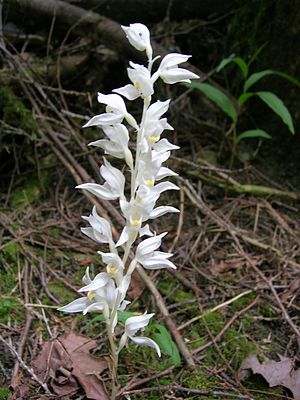Cephalanthera austiniae
| Cephalanthera austiniae | ||||||||||||
|---|---|---|---|---|---|---|---|---|---|---|---|---|

Cephalanthera austiniae |
||||||||||||
| Systematics | ||||||||||||
|
||||||||||||
| Scientific name | ||||||||||||
| Cephalanthera austiniae | ||||||||||||
| ( A.Gray ) A.Heller |
Cephalanthera austiniae is a species of the genus of Waldvöglein ( cephalanthera ) in the family of orchid (Orchidaceae). Native to the western United States and Canada , it is the only species of the genus Cephalanthera outside of Europe and Asia, and one of three species thatdependsentirely on symbiotic mycorrhiza for food. It was named in honor of the American botanist Rebecca Merritt Austin who collected the type evidence.
description
The plant reaches a height of 19 to 65 cm and is pure white in color. The leaves are initially pure white and later turn brown. They have regressed to dry-skinned, sheathed, up to 10 cm long scale sheets, the upper ones are smaller.
In the inflorescence the lower, also dry-skinned bracts are often still leaf-like, the upper ones mostly receding, lanceolate, pointed. The flowers stand at an angle, are half open, white in color and have a vanilla odor. The sepals (sepals) reach a size of 12 to 20 × 4 to 7 mm and have a lanceolate-elliptical shape with a broadened base and a blunt to pointed tip. They are bent forward but do not touch each other. The lateral petals (petals) are oblanceolate, curved, 10 to 17 × 3 to 6 mm in size and connected to the sepal on the back. The lip measures 8 to 12 × 9 to 14 mm and is three-lobed. It is divided into a hypochil and an epichil by a constriction . The hypochil is sagging at the bottom, its side lobes surround the column. The epichil is bent down, the upper side is colored yellow in the middle and has thickened, parallel lamellae. The capsule fruits are 15 × 10 mm in size, upright and elliptical-lanceolate in outline.
distribution
Cephalanthera austiniae thrives on mineral soils in moist to dry coniferous forests . Altitudes between 0 and 2200 meters can be settled.
The distribution area is in western North America in the US states California , Idaho , Oregon and Washington as well as in southern British Columbia in Canada.
ecology
This mykoheterotrophic orchid species has no chlorophyll , so it does not make energy from sunlight by itself. Instead, it lives heterotrophically on fungi, on which it parasitizes .
Individual evidence
- ↑ Xinqi Chen, Stephan W. Gale, Phillip J. Cribb: Cephalanthera . In: Wu Zheng-yi, Peter H. Raven, Deyuan Hong (Eds.): Flora of China . Volume 25: Orchidaceae . Science Press / Missouri Botanical Garden Press, Beijing / St. Louis 2009, ISBN 978-1-930723-90-0 , pp. 174-177 (English, online ).
- ^ A b c Ronald A. Coleman: The Wild Orchids of California. Cornell University Press, 2002, ISBN 0-80-148782-X ( limited preview in Google Book Search).
- ^ A b c d Charles J. Sheviak, Paul M. Catling: Cephalanthera. In: Flora of North America Editorial Committee (Ed.): Flora of North America North of Mexico . Volume 26: Magnoliophyta: Liliidae: Liliales and Orchidales . Oxford University Press, New York / Oxford a. a. 2002, ISBN 0-19-515208-5 , pp. 583-584 (English, online ).
